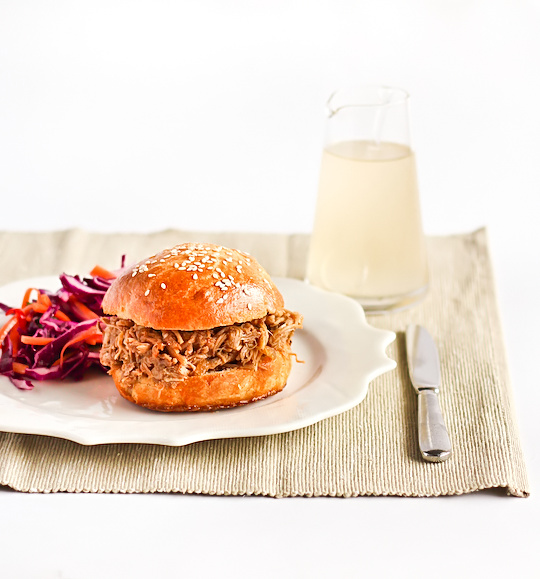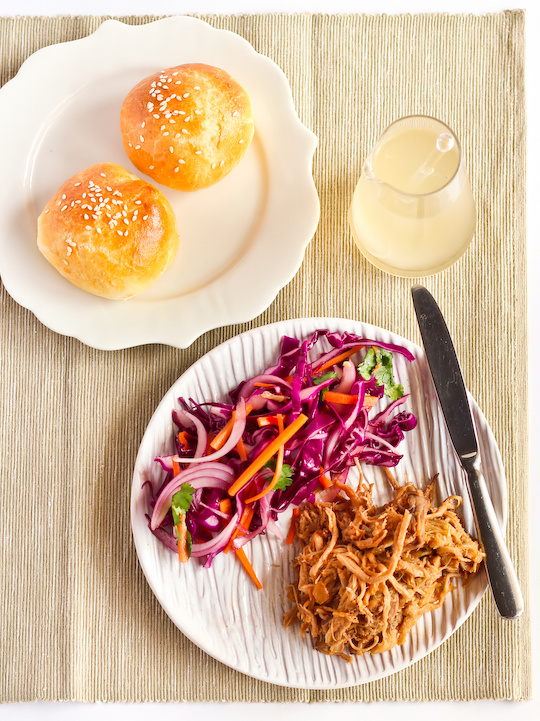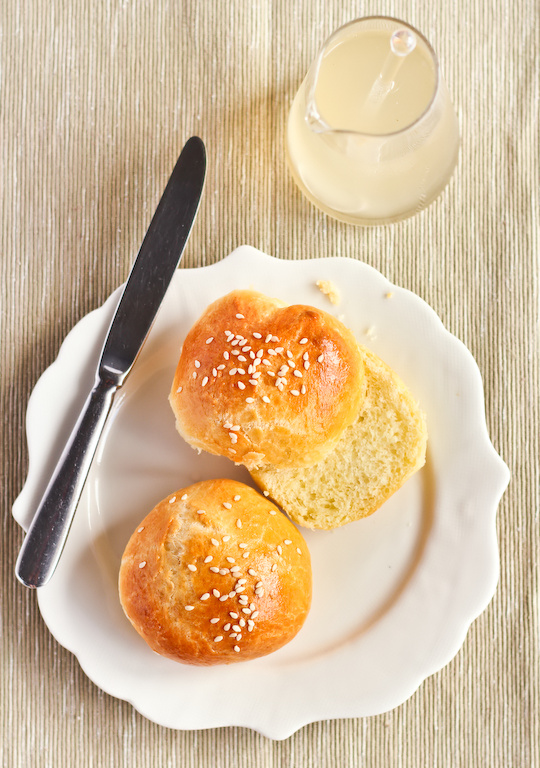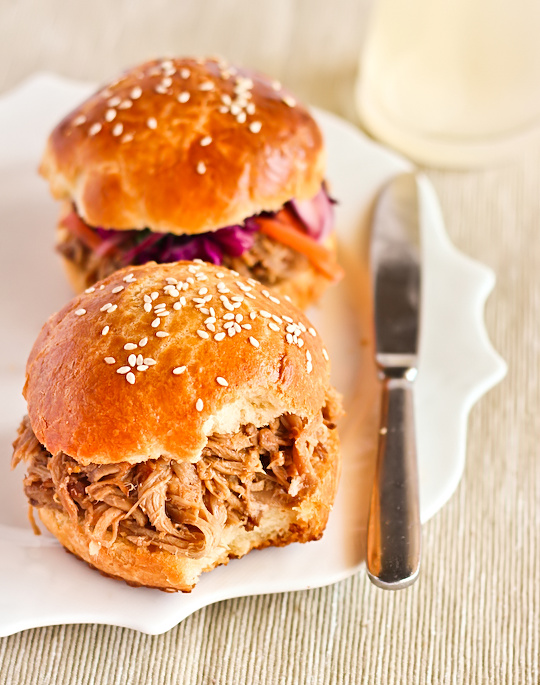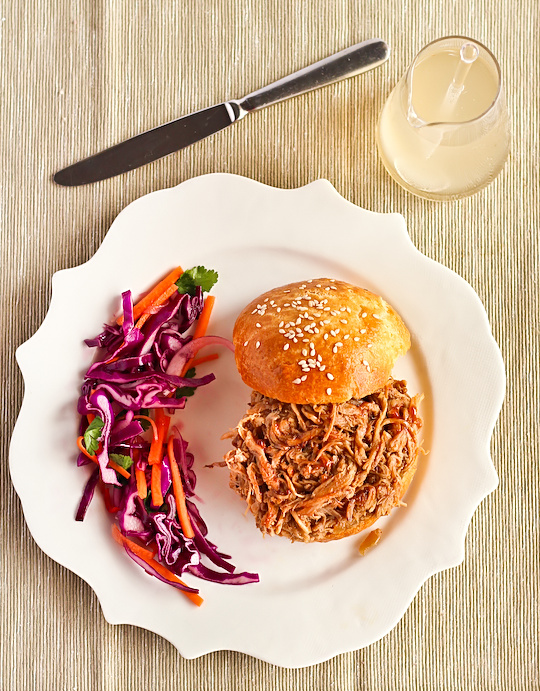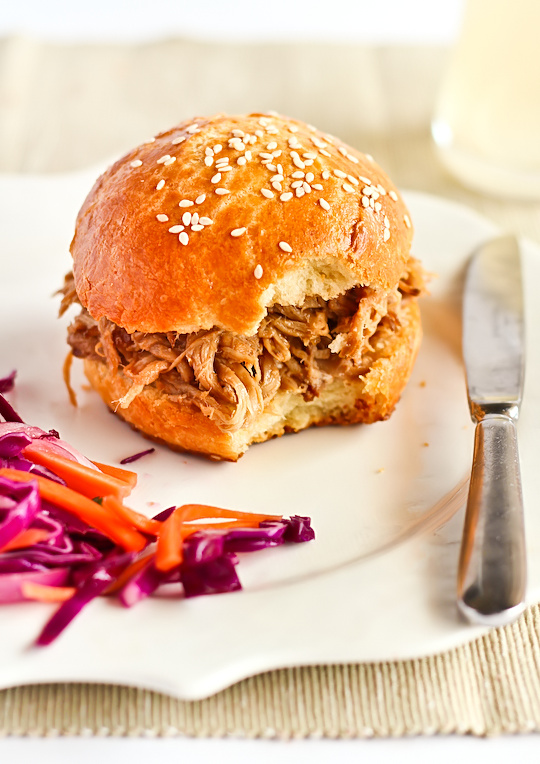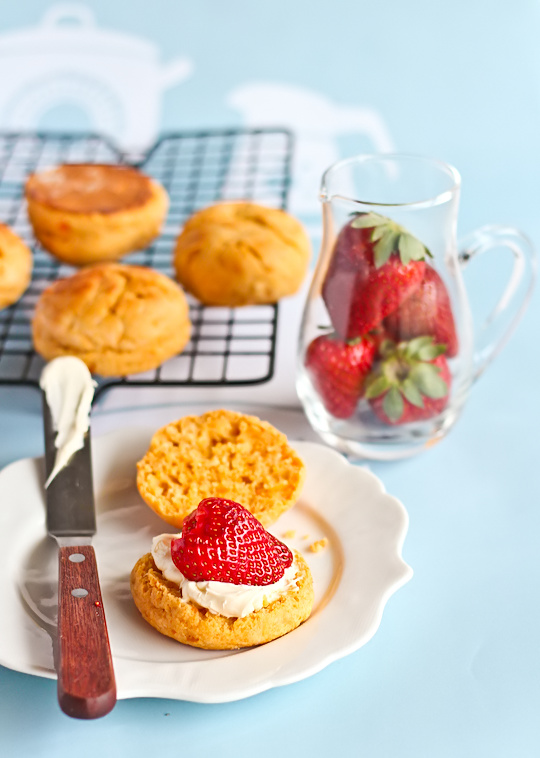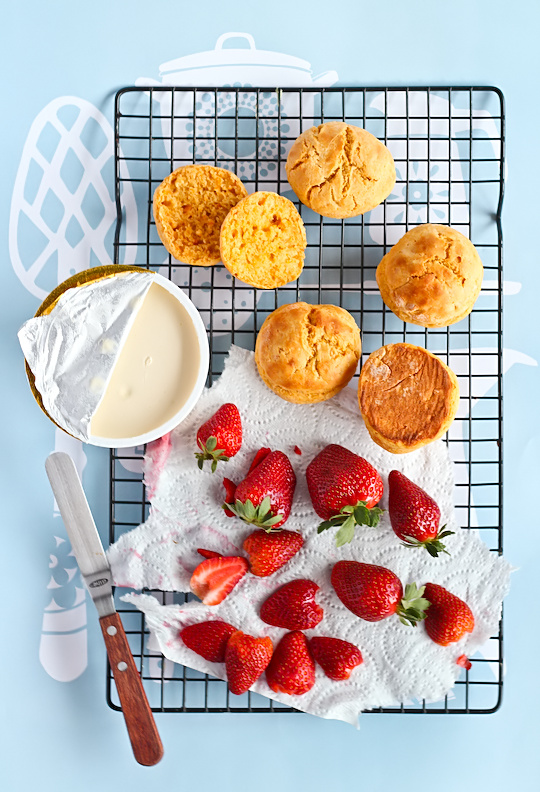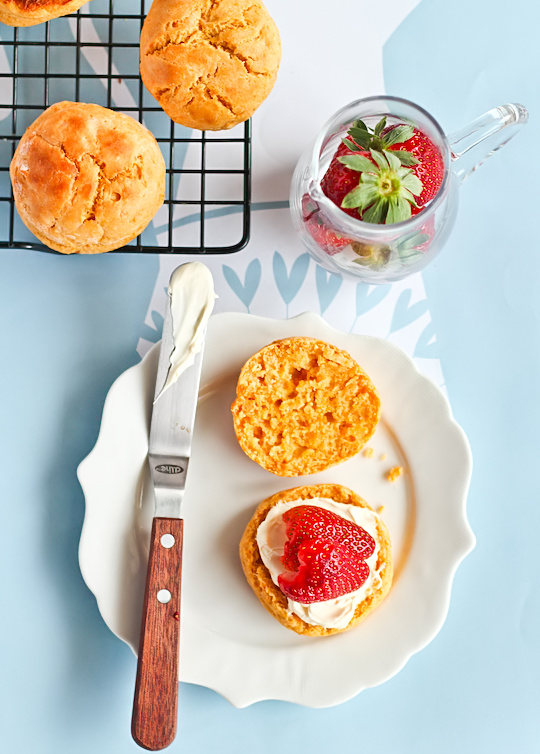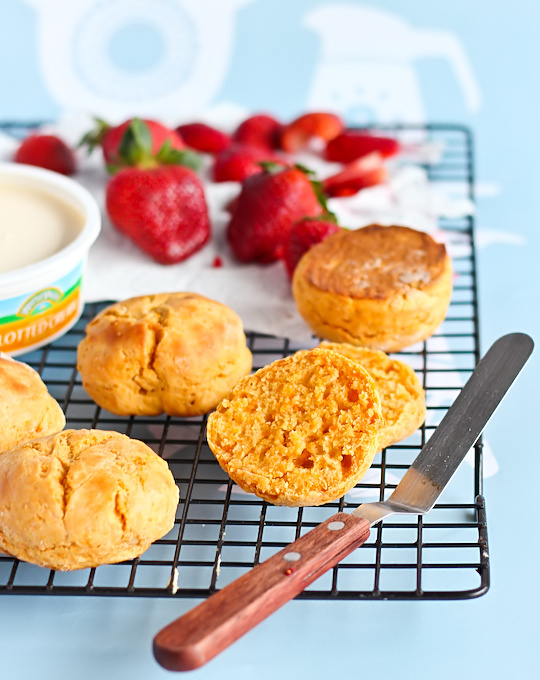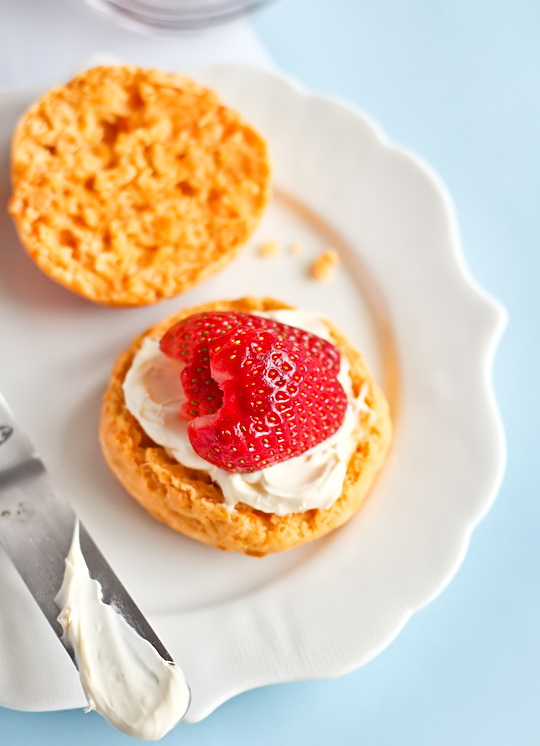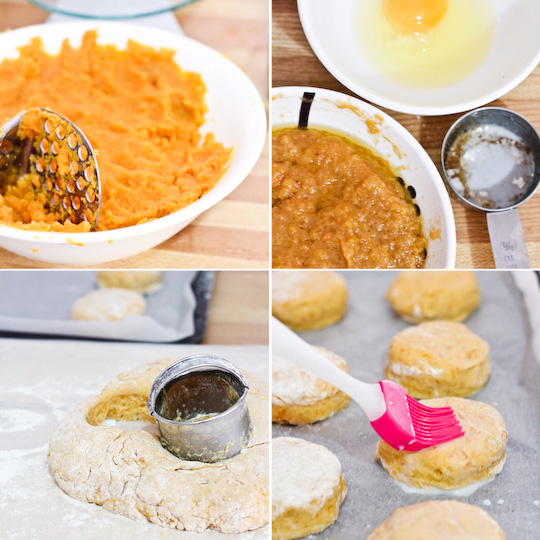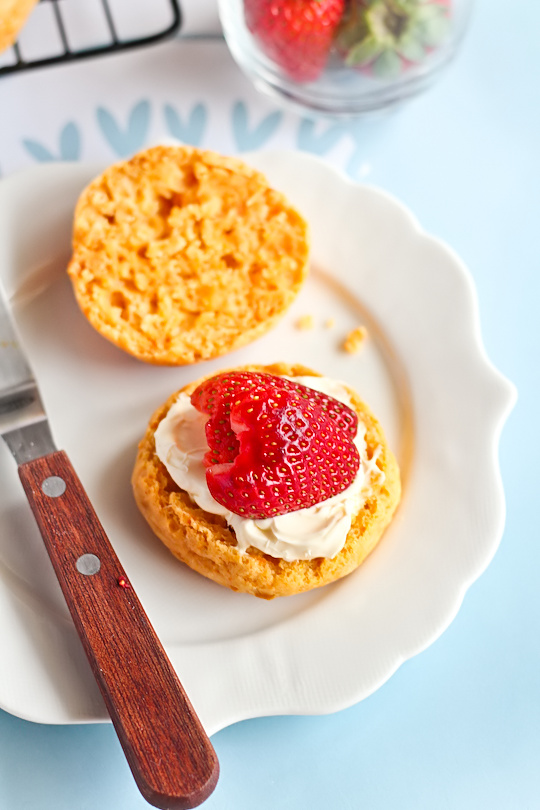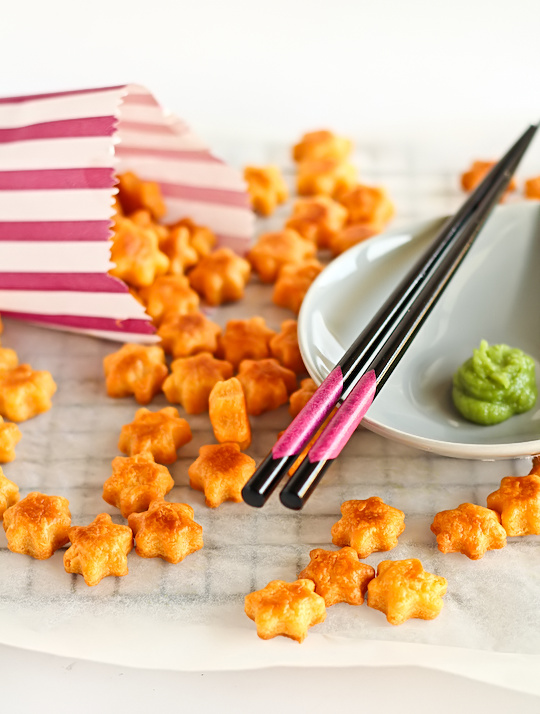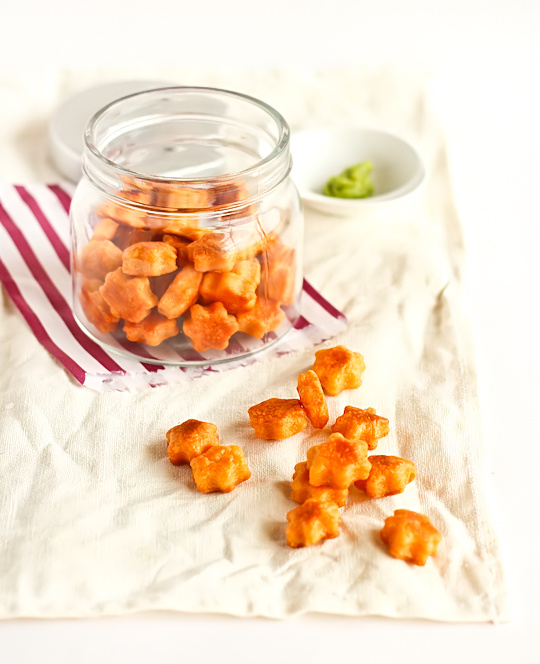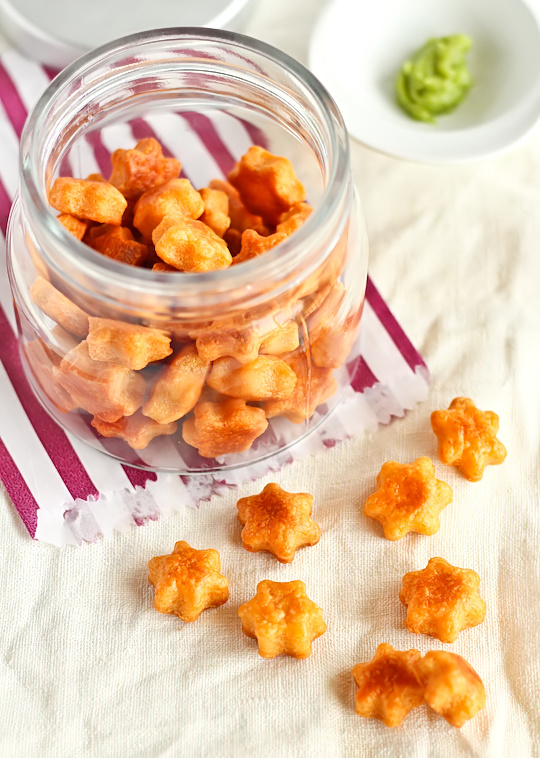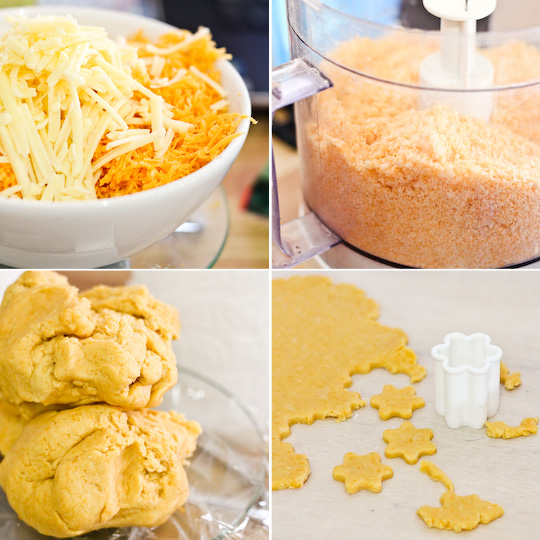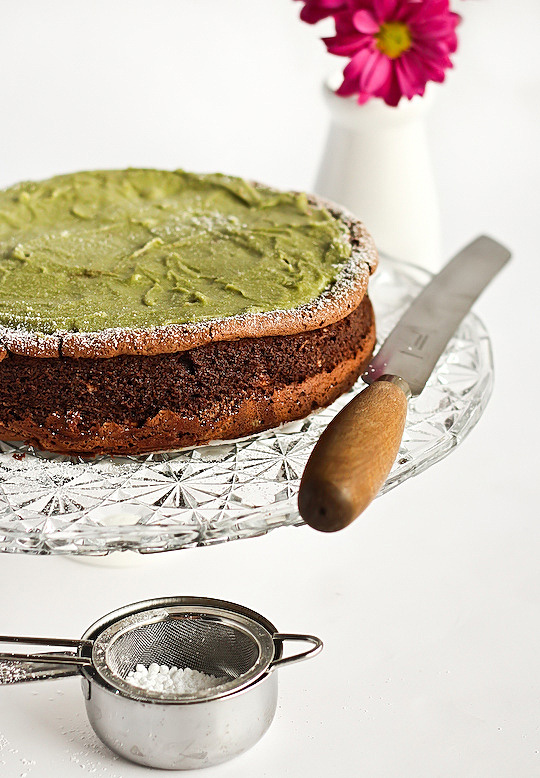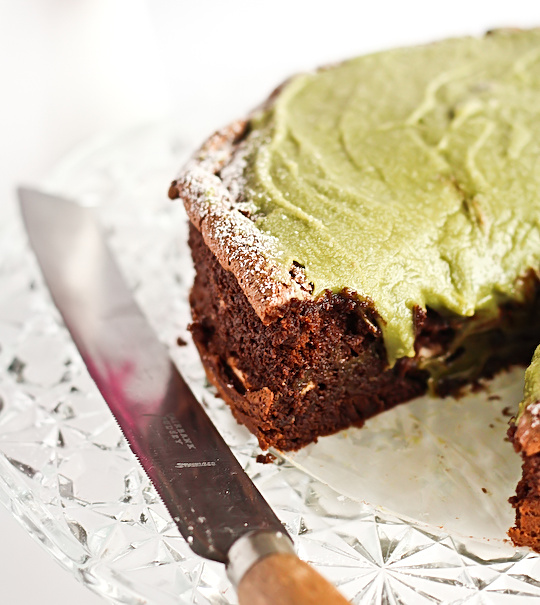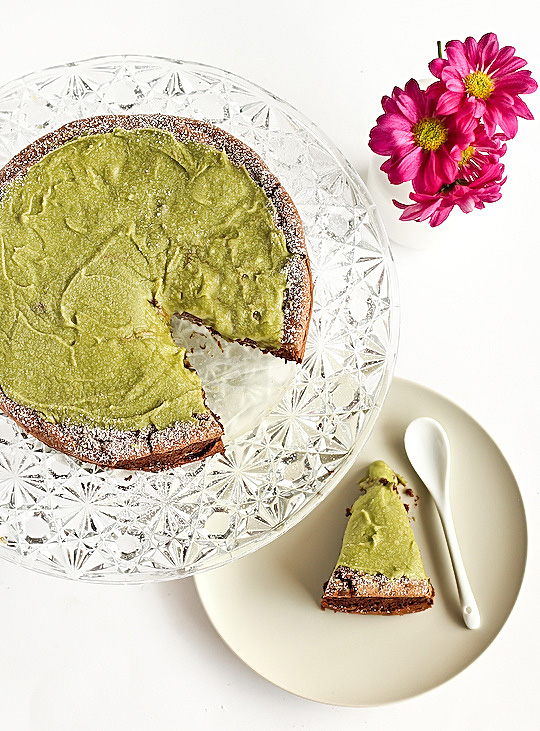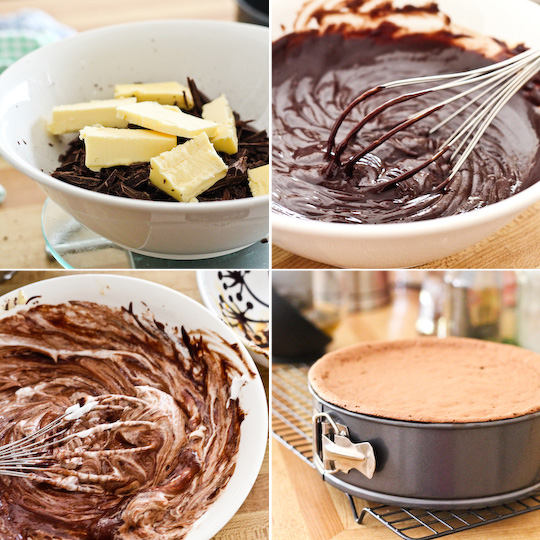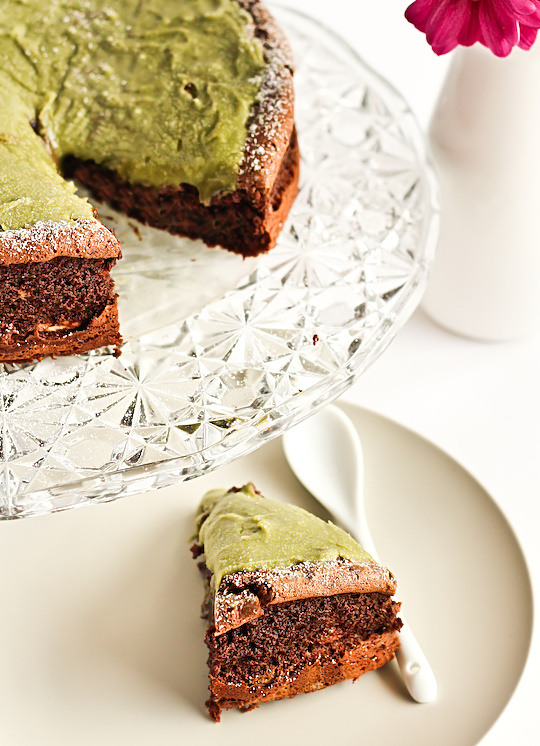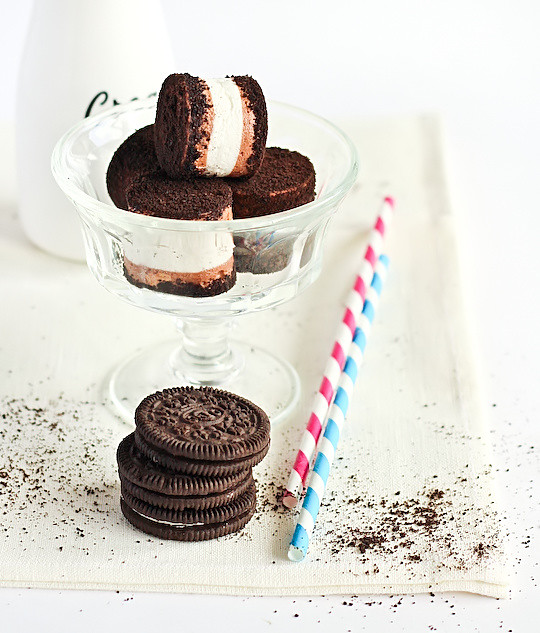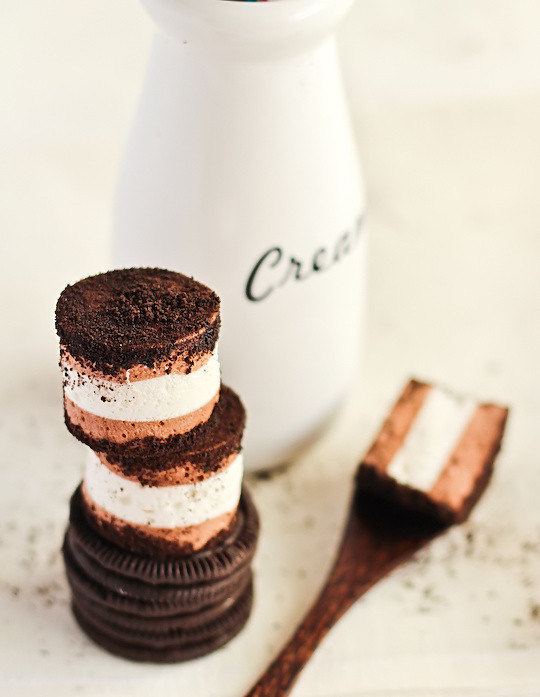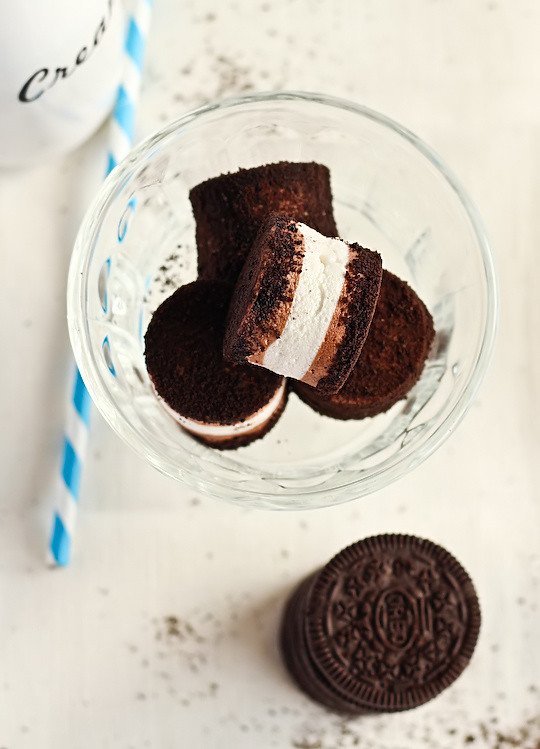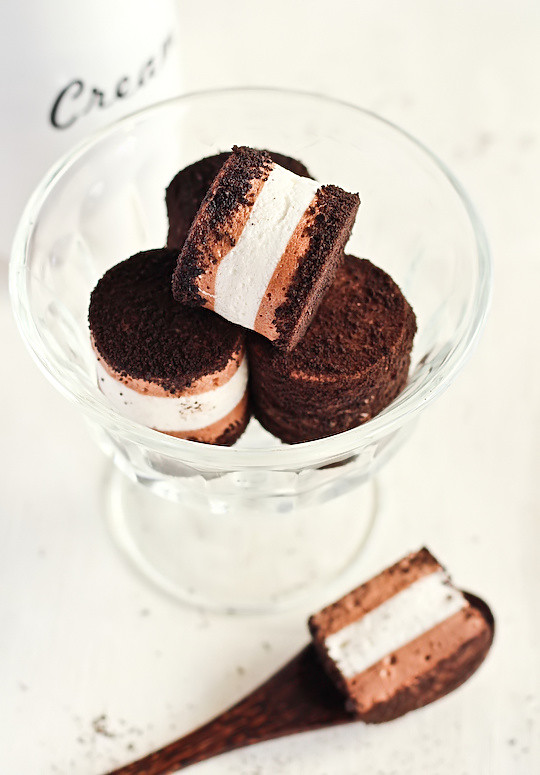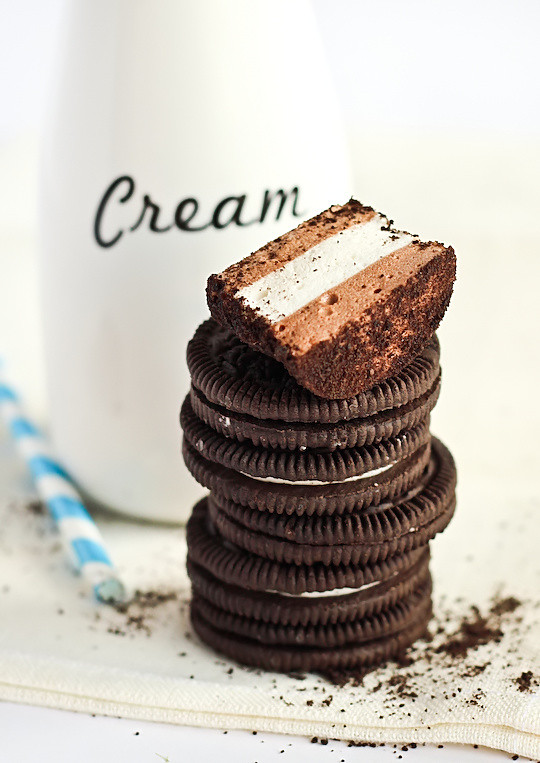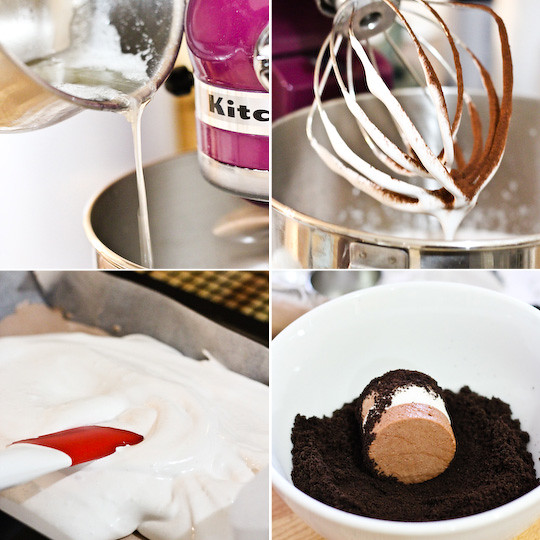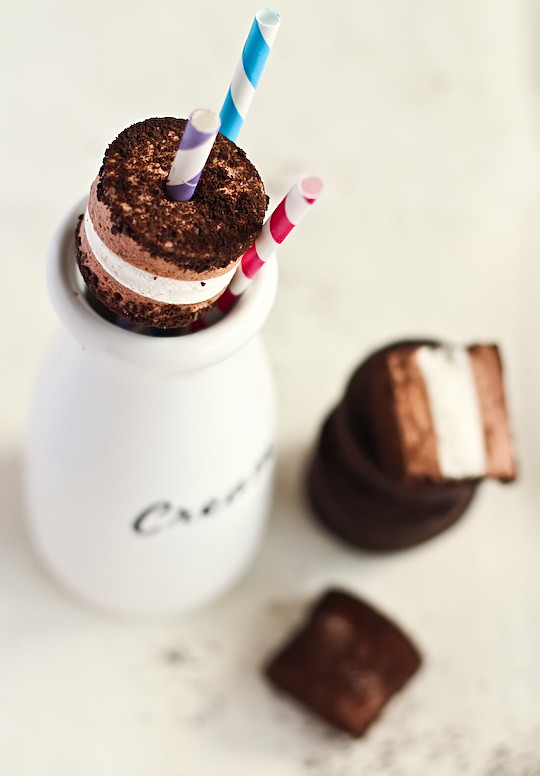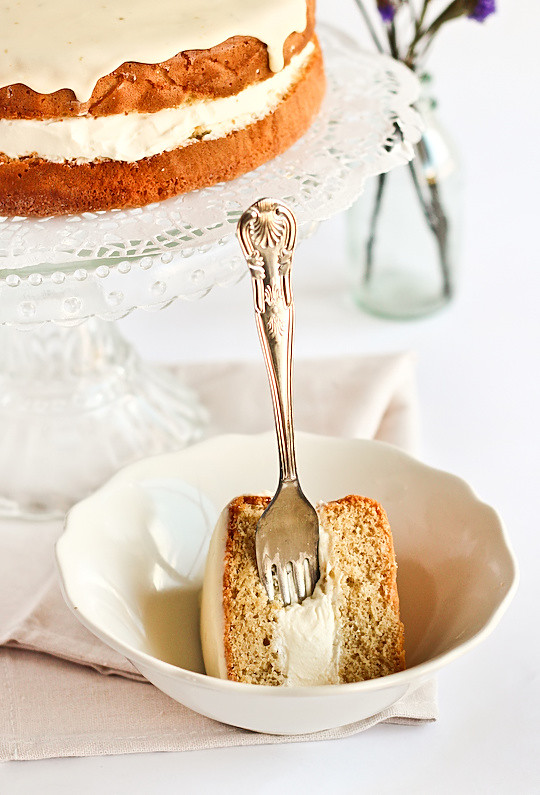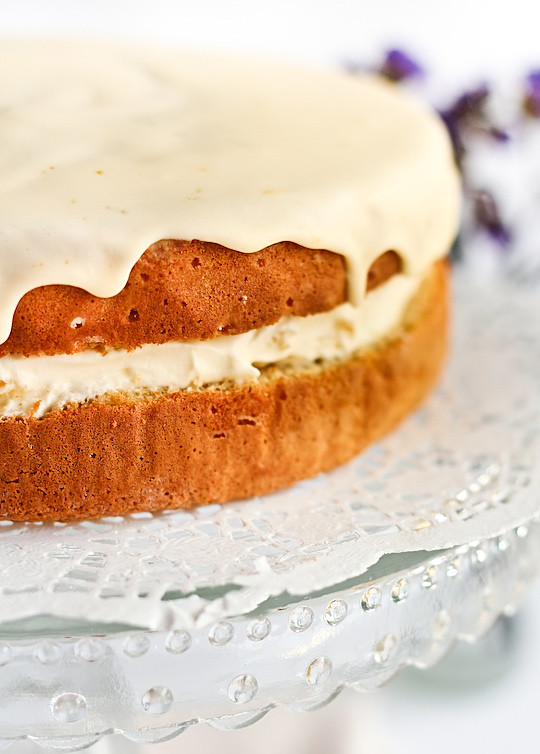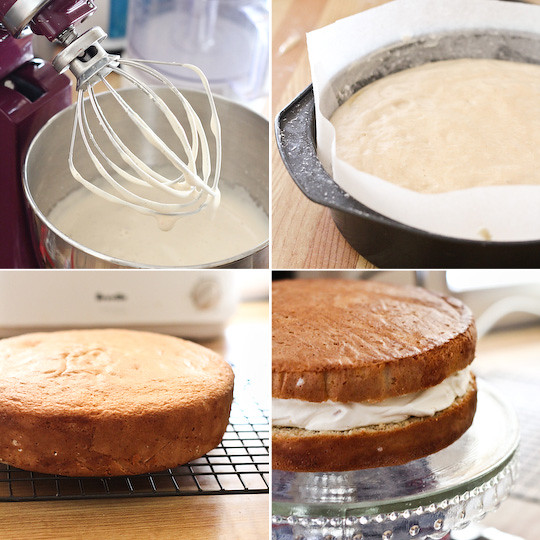Are you ready for this? I've been slaving away in the kitchen all the weekend so I could bring you this amazing meal. Hah! I lie. I've actually been lazing around watching TV while I let all my kitchen appliances do the work for me. I'm in love with my slow cooker and the dough hook attachment on my stand mixer because it means I get to eat 10-hour slow cooked Ginger Beer Pulled Pork on buttery Brioche Buns and served with a spicy, colourful coleslaw. I love my kitchen appliances.
This pork is magical. The smell is unbearably mouth-watering as it cooks, the meat is so fall-apart tender and juicy, and the sauce makes you want to weep with happiness. I might be exaggerating a bit but it's still pretty effing good. An entire pork shoulder (or pork butt to US readers) rubbed in a wonderful spice mix and then slow cooked in a bit of ketchup, onions, mustard, Worchestershire and lots and lots of ginger beer. I just kept adding things to the mixture until I was happy. It tastes so good AND it involves ginger beer. I still blame Lisa for my ginger beer obsession. And my pulled pork obsession. So you can blame Lisa for this post :)
The ginger beer isn't particularly strong so you can't really distinguish its flavour in the pork or the sauce, but it adds a lovely sweetness and a little kick. If you wanted to up the ginger flavour you could probably add a small piece of fresh ginger into the cooking liquid or add some ground ginger to the spice rub. When you eat this pulled pork mixed up with the sauce on top of buttery, eggy, slightly sweet and freshly baked brioche buns you end up with flavour perfection. There's such a great balance of sweet, salty, spicy and sour.
I used my usual recipe for brioche that I've blogged about previously. Even though I kept putting off this recipe idea because I kept thinking that the brioche was painfully complicated, I was surprised to find that the recipe was very straightforward; there's just a lot of waiting time while you while the dough is proving. It's definitely worth the wait, the end result are these pillow-soft, rich and buttery rolls that are perfect for eating with the pork. Or with burgers. Or shaped into hotdog buns. Or eaten with strawberry jam. Or kaya and salted butter! It's good with everything and it's good on its own.
I served these pulled pork buns with a Vietnamese-inspired red cabbage coleslaw with pickled carrots, red onion and coriander and a fish sauce, vinegar, lime and chilli dressing. I love the bright purple colour of this salad and the light dressing that's packed full of flavour. These days I love to make this coleslaw recipe as an alternative to the heavier, creamy mayo coleslaws. And can you believe it, two savoury recipes in the space of one month after a year of no savoury recipes! I need figure out where I left my sweet tooth. While I'm doing that, find some free time to make this recipe. I know the ingredients list looks long but you can adapt the pork depending on what you have available - try it with dijon instead of wholegrain mustard, or cook it in ginger beer and add whatever sauce to the pork later if you're feeling lazy.
Ginger Beer Pulled Pork
(serves 6-8 people)
1 pork shoulder, about 1.5-2kg
2 small-medium brown onions, diced
1 tbsp paprika
2 tsp cumin seeds
2 tsp hot chilli powder (I love it spicy so I doubled this amount)
3 tsp freshly ground pepper
1 tbsp salt (I used sea salt flakes but not necessary)
1 tsp Wholegrain mustard
2 tbsp apple cider vinegar
2 tbsp ketchup
2 tbsp Worchestershire sauce
2 cups ginger beer plus extra if needed (Replace with ginger ale if you can't get ginger beer)
To serve: Warm brioche buns (recipe below) and spicy coleslaw (recipe here)
You will need to begin this recipe (and the brioche) a day in advance. Place cumin seeds in a mortar & pestle and grind well. Add chilli powder, paprika, salt and pepper and mix together. Rub mixture all over the surface of the pork, you may end up with excess depending on the size of your pork shoulder. Place onions, mustard, apple cider vinegar, ketchup, Worchestershire sauce and ginger beer in your slow cooker pot and add pork. Cook on low for about 9-10 hours or medium for about 6-7 hours. You may want to flip the pork over halfway through, but it's not necessary. (If you don't have a slow cooker you could try placing the ingredients in a cast iron pot with the lid on and baking in the oven at 150°C (300°F) for around 5-5.5 hours (Thanks V!), you may need to top up the liquid in the pot with extra ginger beer every couple of hours, until the pork is tender enough, but I haven't tested this method so no guarantees!)
Remove the pork from its juices, but keep the leftover liquid. Using two forks, shred the pork meat, it should fall apart easily. If not you may need to cook the meat for longer. Either by turning on the slow cooker on medium with the lid open or placing the leftover liquid in a saucepan on medium heat, reduce the liquid until it starts to thicken slightly. At this point you can add any extra condiments to taste, I added about 1/3 cup extra ginger beer to give it a bit more sweetness. You could also add some barbeque sauce if you like. Add the pork back to the reduced sauce and mix together. Serve warm on brioche buns (recipe below), ideally served with a spicy slaw (recipe here)
Brioche Buns
(makes 12 buns or 24 mini buns, adapted from my previous recipe here)
7g (1 packet) active dry yeast
2 tbsp sugar
1/3 cup lukewarm milk
3 cups plain flour
1 tsp salt
4 large eggs, beaten
200g butter, cut into small pieces and softened
Egg wash: 1 large egg yolk, lightly beaten with 1 tbsp milk
Optional: Sesame seeds to top off buns
Mix the yeast, 1 teaspoon of sugar and the milk in a small bowl. Set aside for 10 minutes until frothy. Combine the flour, remaining sugar and salt in a large bowl. Make a well in the centre and pour the eggs, milk and yeast mixture.
Knead the dough with an electric mixter fitted with a dough hook for 8-10 minutes, until smooth. Beat the butter, one piece at a time, into the dough with mixer at low speed. Mix for 5 minutes, until the dough is smooth and elastic (it will be quite soft). Place in an oiled bowl, cover with a clean kitchen towel, and leave to rise at room temperatre for 2-3 hours, until doubled in bulk. (The temperature should be about 24°C (75°F), no hotter, as the butter will melt and separate out from the dough)
Punch the risen dough down, turn out onto a lightly floured work surface and knead for 2-3 minutes. Return to the bowl and place in the refrigerator for several hours or overnight.
Split dough into 12 equal portions for regular sized buns, 24 portions for miniature buns (I did half-half). Roll into neat balls and flatten slightly. Place on two baking paper lined baking trays, equally spaced apart. Cover and leave for an hour at room temperature. Preheat the oven to 220°C (428°F). Lightly glaze the buns with egg wash and sprinkle a pinch of sesame seeds on top of each. Bake for 10 minutes, then reduce temperature to 190°C (375°F) and bake for another 10 mins (only 5 mins for the mini buns) or until golden brown on top and a skewer inserted into the centre comes out clean. I baked one tray at a time in my small oven, but if you're baking two trays you will want to switch the top and bottom tray around halfway through. Remove the brioche from the tray immediately and let cool on a rack.
This pork is magical. The smell is unbearably mouth-watering as it cooks, the meat is so fall-apart tender and juicy, and the sauce makes you want to weep with happiness. I might be exaggerating a bit but it's still pretty effing good. An entire pork shoulder (or pork butt to US readers) rubbed in a wonderful spice mix and then slow cooked in a bit of ketchup, onions, mustard, Worchestershire and lots and lots of ginger beer. I just kept adding things to the mixture until I was happy. It tastes so good AND it involves ginger beer. I still blame Lisa for my ginger beer obsession. And my pulled pork obsession. So you can blame Lisa for this post :)
The ginger beer isn't particularly strong so you can't really distinguish its flavour in the pork or the sauce, but it adds a lovely sweetness and a little kick. If you wanted to up the ginger flavour you could probably add a small piece of fresh ginger into the cooking liquid or add some ground ginger to the spice rub. When you eat this pulled pork mixed up with the sauce on top of buttery, eggy, slightly sweet and freshly baked brioche buns you end up with flavour perfection. There's such a great balance of sweet, salty, spicy and sour.
I used my usual recipe for brioche that I've blogged about previously. Even though I kept putting off this recipe idea because I kept thinking that the brioche was painfully complicated, I was surprised to find that the recipe was very straightforward; there's just a lot of waiting time while you while the dough is proving. It's definitely worth the wait, the end result are these pillow-soft, rich and buttery rolls that are perfect for eating with the pork. Or with burgers. Or shaped into hotdog buns. Or eaten with strawberry jam. Or kaya and salted butter! It's good with everything and it's good on its own.
I served these pulled pork buns with a Vietnamese-inspired red cabbage coleslaw with pickled carrots, red onion and coriander and a fish sauce, vinegar, lime and chilli dressing. I love the bright purple colour of this salad and the light dressing that's packed full of flavour. These days I love to make this coleslaw recipe as an alternative to the heavier, creamy mayo coleslaws. And can you believe it, two savoury recipes in the space of one month after a year of no savoury recipes! I need figure out where I left my sweet tooth. While I'm doing that, find some free time to make this recipe. I know the ingredients list looks long but you can adapt the pork depending on what you have available - try it with dijon instead of wholegrain mustard, or cook it in ginger beer and add whatever sauce to the pork later if you're feeling lazy.
Ginger Beer Pulled Pork
(serves 6-8 people)
1 pork shoulder, about 1.5-2kg
2 small-medium brown onions, diced
1 tbsp paprika
2 tsp cumin seeds
2 tsp hot chilli powder (I love it spicy so I doubled this amount)
3 tsp freshly ground pepper
1 tbsp salt (I used sea salt flakes but not necessary)
1 tsp Wholegrain mustard
2 tbsp apple cider vinegar
2 tbsp ketchup
2 tbsp Worchestershire sauce
2 cups ginger beer plus extra if needed (Replace with ginger ale if you can't get ginger beer)
To serve: Warm brioche buns (recipe below) and spicy coleslaw (recipe here)
You will need to begin this recipe (and the brioche) a day in advance. Place cumin seeds in a mortar & pestle and grind well. Add chilli powder, paprika, salt and pepper and mix together. Rub mixture all over the surface of the pork, you may end up with excess depending on the size of your pork shoulder. Place onions, mustard, apple cider vinegar, ketchup, Worchestershire sauce and ginger beer in your slow cooker pot and add pork. Cook on low for about 9-10 hours or medium for about 6-7 hours. You may want to flip the pork over halfway through, but it's not necessary. (If you don't have a slow cooker you could try placing the ingredients in a cast iron pot with the lid on and baking in the oven at 150°C (300°F) for around 5-5.5 hours (Thanks V!), you may need to top up the liquid in the pot with extra ginger beer every couple of hours, until the pork is tender enough, but I haven't tested this method so no guarantees!)
Remove the pork from its juices, but keep the leftover liquid. Using two forks, shred the pork meat, it should fall apart easily. If not you may need to cook the meat for longer. Either by turning on the slow cooker on medium with the lid open or placing the leftover liquid in a saucepan on medium heat, reduce the liquid until it starts to thicken slightly. At this point you can add any extra condiments to taste, I added about 1/3 cup extra ginger beer to give it a bit more sweetness. You could also add some barbeque sauce if you like. Add the pork back to the reduced sauce and mix together. Serve warm on brioche buns (recipe below), ideally served with a spicy slaw (recipe here)
Brioche Buns
(makes 12 buns or 24 mini buns, adapted from my previous recipe here)
7g (1 packet) active dry yeast
2 tbsp sugar
1/3 cup lukewarm milk
3 cups plain flour
1 tsp salt
4 large eggs, beaten
200g butter, cut into small pieces and softened
Egg wash: 1 large egg yolk, lightly beaten with 1 tbsp milk
Optional: Sesame seeds to top off buns
Mix the yeast, 1 teaspoon of sugar and the milk in a small bowl. Set aside for 10 minutes until frothy. Combine the flour, remaining sugar and salt in a large bowl. Make a well in the centre and pour the eggs, milk and yeast mixture.
Knead the dough with an electric mixter fitted with a dough hook for 8-10 minutes, until smooth. Beat the butter, one piece at a time, into the dough with mixer at low speed. Mix for 5 minutes, until the dough is smooth and elastic (it will be quite soft). Place in an oiled bowl, cover with a clean kitchen towel, and leave to rise at room temperatre for 2-3 hours, until doubled in bulk. (The temperature should be about 24°C (75°F), no hotter, as the butter will melt and separate out from the dough)
Punch the risen dough down, turn out onto a lightly floured work surface and knead for 2-3 minutes. Return to the bowl and place in the refrigerator for several hours or overnight.
Split dough into 12 equal portions for regular sized buns, 24 portions for miniature buns (I did half-half). Roll into neat balls and flatten slightly. Place on two baking paper lined baking trays, equally spaced apart. Cover and leave for an hour at room temperature. Preheat the oven to 220°C (428°F). Lightly glaze the buns with egg wash and sprinkle a pinch of sesame seeds on top of each. Bake for 10 minutes, then reduce temperature to 190°C (375°F) and bake for another 10 mins (only 5 mins for the mini buns) or until golden brown on top and a skewer inserted into the centre comes out clean. I baked one tray at a time in my small oven, but if you're baking two trays you will want to switch the top and bottom tray around halfway through. Remove the brioche from the tray immediately and let cool on a rack.

